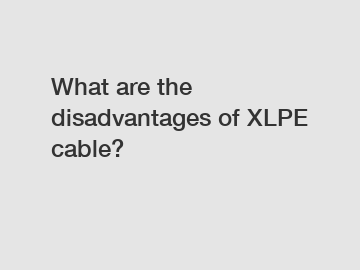Jan. 04, 2024
Electrical Equipment
What are the disadvantages of XLPE cable?
XLPE (cross-linked polyethylene) cables have gained popularity in various industries due to their excellent electrical properties and durability. They are widely used for power transmission and distribution systems, as well as in communication networks. However, like any other technology, XLPE cables also have their disadvantages. In this article, we will explore some of the downsides of using XLPE cables.
1. Limited temperature rating:

One of the main drawbacks of XLPE cables is their limited temperature rating. While they can withstand high temperatures when in operation, they can become brittle and easily damaged in extreme cold temperatures. This limited temperature rating can be a disadvantage in certain applications, particularly in regions with harsh winter conditions.
2. Higher cost:
Compared to traditional PVC (polyvinyl chloride) cables, XLPE cables are generally more expensive. The manufacturing process of XLPE cables is complex and requires specialized equipment, which adds to the overall cost. Additionally, the raw materials used in XLPE cables are more expensive than those used in PVC cables. Therefore, when considering the installation of XLPE cables, the higher cost must be taken into account.
3. Difficult to repair:
XLPE cables are not as easy to repair as other types of cables. Once an XLPE cable is damaged, it often requires complete replacement rather than a simple repair. This can lead to increased downtime and higher costs. In comparison, with cables such as PVC or rubber insulated cables, a damaged section can be cut out and replaced without having to replace the entire cable.
4. Susceptibility to moisture:
While XLPE insulation provides excellent electrical properties, it is more susceptible to moisture compared to other types of insulation. This can be a disadvantage in areas with high humidity, as moisture can penetrate the insulation and degrade the cable's performance. To protect XLPE cables from moisture, additional measures such as proper sealing and insulation barriers must be taken.
5. Limited flexibility:
XLPE cables are relatively stiff and have limited flexibility compared to other cables, such as rubber-insulated cables. This can make installation and routing more challenging, particularly in applications where cables need to be bent around corners or in confined spaces. The limited flexibility of XLPE cables can also lead to increased stress on the cable and potential damage if not installed properly.
6. Environmental concerns:
The production and disposal of XLPE cables can have environmental implications. The manufacturing process of XLPE cables requires the use of chemicals and energy-intensive processes. Additionally, XLPE cables are not biodegradable and can cause environmental harm if not properly disposed of at the end of their life cycle. Therefore, it is important to consider the environmental impact when choosing XLPE cables.
In conclusion, while XLPE cables offer numerous advantages, they also have a few disadvantages that need to be taken into consideration. These include their limited temperature rating, higher cost, difficulty in repair, susceptibility to moisture, limited flexibility, and environmental concerns. Despite these downsides, XLPE cables continue to be widely used in various industries due to their overall performance and reliability.
If you have any questions about XLPE cables or need assistance with your cable installation, please do not hesitate to contact us. Our team of experts is ready to provide you with the support and guidance you need.
Want more information on h03rn f, silicone rubber cable manufacturer, superflex flexible welding cable manufacturers? Feel free to contact us.
Previous: What causes a limit switch to fail?
Next: 8 Tips for Maximizing the Potential of Ni-MH Battery Packs
If you are interested in sending in a Guest Blogger Submission,welcome to write for us!
All Comments ( 0 )